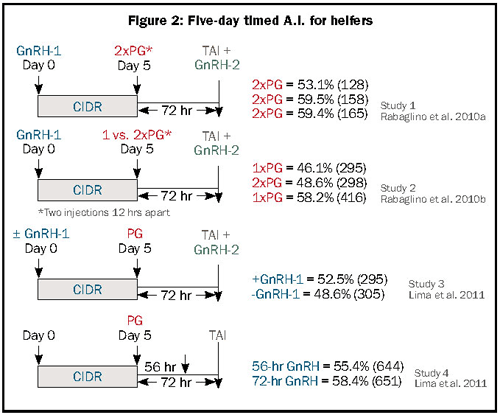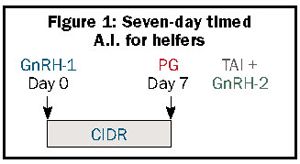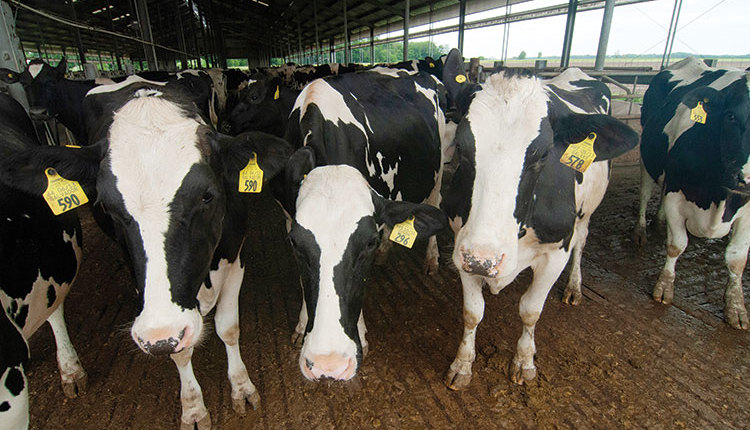The author is professor of animal sciences at Kansas State University, Manhattan.
One of the most valuable resources on any dairy is the replacement heifer. As a group, they represent the most fertile population of females on the farm. In addition, if your sire selection has been wise, heifers will be genetically superior to their dams and should continue to bring great pride to your breeding program.
Since the late 1990s when timed A.I. breeding programs such as Ovsynch were introduced for lactating cows, there have been attempts to develop successful programs for heifers. These programs have been tested, and some potentially reliable timed A.I. programs are now emerging. These programs can be applied regardless of the number of heifers to be inseminated each week.
Let's examine the results of some recent studies that were conducted with dairy heifers.
Seven-day programs
When heifers are inseminated after detected estrus without any hormone synchronization, it is not uncommon for conception rates to exceed 60 percent. Even when inseminations were performed after PG (prostaglandin) injections and inseminations were made after detected estrus, conception rates were commonly greater than 60 percent. These are traditional and proven ways to inseminate heifers, but they require time and skilled labor for heat detection.
When applying timed A.I. in heifers, pregnancy rates will be slightly reduced to the mid-50 percent range when the CIDR insert containing progesterone is used for seven days and PG is injected upon its removal in addition to two GnRH injections (see Figure 1).

These results held true for the seven-day CIDR program when heifers were inseminated after detected estrus up until 72 hours after PG and then the remaining heifers were injected with GnRH and inseminated at 72 hours in the absence of estrus.
Five-day programs
A series of recent studies were conducted at the University of Florida in a large number of dairy heifers. A variety of five-day programs were tested in multiple experiments.
 In Study 1 (see Figure 2), ovulation in dairy heifers was synchronized and two injections of PG were administered on Day 5; one when the CIDR insert was removed and another 12 hours later. Pregnancy rates did not differ in two separate experiments but ranged from 53 to 59 percent.
In Study 1 (see Figure 2), ovulation in dairy heifers was synchronized and two injections of PG were administered on Day 5; one when the CIDR insert was removed and another 12 hours later. Pregnancy rates did not differ in two separate experiments but ranged from 53 to 59 percent.
In Study 2 (see Figure 2), a comparison was made between using one or two PG injections at the time of CIDR insert removal. No differences in pregnancy rates were detected in two experiments.
In Study 3 (see Figure 2), only one PG injection was employed but the researchers addressed the need for the GnRH-1 injection. Results from Study 3 showed no advantage for employing the GnRH-1 injection when one PG injection was administered because pregnancy rates ranged from 48 to 52 percent.
In Study 4 (see Figure 2), no GnRH-1 injection was employed with only one PG injection and the proper timing of GnRH-2 was tested. Results showed that the inconvenience of handling the heifers an extra time to administer GnRH-2 at 56 hours (16 hours before the timed A.I.) was not necessary for all heifers in the study. In contrast, for those heifers that did not show estrus during the 72 hours after PG and CIDR removal, extending the time to the GnRH to 72 hours (coinciding with the timed A.I.) improved their pregnancy outcome from 44.7 to 53 percent.
There is one more study from the Florida group involving 1,106 heifers. It has shown that when GnRH-1 is administered at the time of the CIDR insertion in a five-day program that administering two PG injections (24 hours apart; one with CIDR insert removal and one 24 hours later) was advantageous to improve pregnancy rates by 6 percent. The study comparison was not employing GnRH-1 and using only one PG injection (59.4 percent versus 53.5 percent).
Bringing it together
Studies have shown we can now successfully synchronize ovulation in heifers with CIDR inserts followed by GnRH and PG in five-day programs. Several options can work. The results indicated that the five-day program is effective and the GnRH-1 injection is not necessary when using only one PG injection. Extending the timing of the GnRH-2 to 72 hours (coinciding with the timed A.I.) benefitted heifers that did not show estrus during the 72 hours after CIDR insert removal. Choose the option best suited for your dairy operation.
Click here to return to the Reproduction E-Sources
120410_255
One of the most valuable resources on any dairy is the replacement heifer. As a group, they represent the most fertile population of females on the farm. In addition, if your sire selection has been wise, heifers will be genetically superior to their dams and should continue to bring great pride to your breeding program.
Since the late 1990s when timed A.I. breeding programs such as Ovsynch were introduced for lactating cows, there have been attempts to develop successful programs for heifers. These programs have been tested, and some potentially reliable timed A.I. programs are now emerging. These programs can be applied regardless of the number of heifers to be inseminated each week.
Let's examine the results of some recent studies that were conducted with dairy heifers.
Seven-day programs
When heifers are inseminated after detected estrus without any hormone synchronization, it is not uncommon for conception rates to exceed 60 percent. Even when inseminations were performed after PG (prostaglandin) injections and inseminations were made after detected estrus, conception rates were commonly greater than 60 percent. These are traditional and proven ways to inseminate heifers, but they require time and skilled labor for heat detection.
When applying timed A.I. in heifers, pregnancy rates will be slightly reduced to the mid-50 percent range when the CIDR insert containing progesterone is used for seven days and PG is injected upon its removal in addition to two GnRH injections (see Figure 1).

These results held true for the seven-day CIDR program when heifers were inseminated after detected estrus up until 72 hours after PG and then the remaining heifers were injected with GnRH and inseminated at 72 hours in the absence of estrus.
Five-day programs
A series of recent studies were conducted at the University of Florida in a large number of dairy heifers. A variety of five-day programs were tested in multiple experiments.
 In Study 1 (see Figure 2), ovulation in dairy heifers was synchronized and two injections of PG were administered on Day 5; one when the CIDR insert was removed and another 12 hours later. Pregnancy rates did not differ in two separate experiments but ranged from 53 to 59 percent.
In Study 1 (see Figure 2), ovulation in dairy heifers was synchronized and two injections of PG were administered on Day 5; one when the CIDR insert was removed and another 12 hours later. Pregnancy rates did not differ in two separate experiments but ranged from 53 to 59 percent.In Study 2 (see Figure 2), a comparison was made between using one or two PG injections at the time of CIDR insert removal. No differences in pregnancy rates were detected in two experiments.
In Study 3 (see Figure 2), only one PG injection was employed but the researchers addressed the need for the GnRH-1 injection. Results from Study 3 showed no advantage for employing the GnRH-1 injection when one PG injection was administered because pregnancy rates ranged from 48 to 52 percent.
In Study 4 (see Figure 2), no GnRH-1 injection was employed with only one PG injection and the proper timing of GnRH-2 was tested. Results showed that the inconvenience of handling the heifers an extra time to administer GnRH-2 at 56 hours (16 hours before the timed A.I.) was not necessary for all heifers in the study. In contrast, for those heifers that did not show estrus during the 72 hours after PG and CIDR removal, extending the time to the GnRH to 72 hours (coinciding with the timed A.I.) improved their pregnancy outcome from 44.7 to 53 percent.
There is one more study from the Florida group involving 1,106 heifers. It has shown that when GnRH-1 is administered at the time of the CIDR insertion in a five-day program that administering two PG injections (24 hours apart; one with CIDR insert removal and one 24 hours later) was advantageous to improve pregnancy rates by 6 percent. The study comparison was not employing GnRH-1 and using only one PG injection (59.4 percent versus 53.5 percent).
Bringing it together
Studies have shown we can now successfully synchronize ovulation in heifers with CIDR inserts followed by GnRH and PG in five-day programs. Several options can work. The results indicated that the five-day program is effective and the GnRH-1 injection is not necessary when using only one PG injection. Extending the timing of the GnRH-2 to 72 hours (coinciding with the timed A.I.) benefitted heifers that did not show estrus during the 72 hours after CIDR insert removal. Choose the option best suited for your dairy operation.
120410_255










